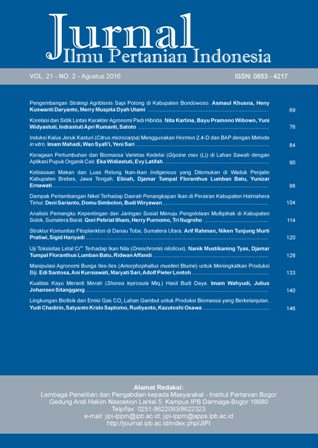Analisis Pemangku Kepentingan dan Jaringan Sosial Menuju Pengelolaan Multipihak di Kabupaten Solok, Sumatera Barat
Abstract
Protected Forest Management Unit (PFMU) of Solok is one of 120 FMU Model that has been set by the government through Ministry of Environment and Forestry (MoEF). Community settlements (Nagari) were around and inside the FMU. Additionally, the existence of the FMU as a new institution in forest management cause different interpretation of the various stakeholders. The objective of this research was to identifying stakeholders and their interest and analyzing the patterns of relationship of stakeholders involved in the management of PFMU Solok. This research was conducted based on stakeholder analysis and social network analysis. Stakeholders involved in management of PFMU Solok have diverse interests and power. There were 22 stakeholders identified, in which 2 were classified as key players, 10 as subject, 4 as context setter, and 6 as crowd. Interaction pattern of stakeholders in the form of information flow was not spread evenly. The result shows that there were many stakeholder in the management of PFMU Solok. Multistakeholder forest management can be an alternative management model to integrate interests of stakeholders and equally distribute information.Downloads
References
Abbas R. 2005. Mekanisme perencanaan partisipasi stakeholders Taman Nasional Gunung Rinjani. [Disertasi]. Bogor (ID): Institut Pertanian Bogor.
Alviya I, Suryandari EY. 2008. Kajian Konsep Kesatuan Pengelolaan Hutan Model Way Terusan Register 47. Jurnal Analisis Kebijakan Kehutanan. 5(2): 101-120.
Barnes C, van Laerhoven F. 2015. Making it last? Analysing the role of NGO interventions in the development of institutions for durable collective action in Indian community forestry. Environmental Science & Policy. 53(2): 192-205. http://doi.org/bm9p
Carter J, Gronow J. 2005. Recent experience in collaborative forest management: a review paper. Bogor (ID): CIFOR.
de Groot R. 2006. Function-analysis and valuation as a tool to assess land use conflicts in planning for sustainable, multi-functional landscapes. Landscape and Urban Planning. 75(34): 175-186. http://doi.org/fmnb7d
Fahmi E, Zakaria RY. 2004. Multi-stakeholder processes dan good governance: minus malum dalam wacana neoliberal?. In: Proceedings Civil Society, Citizenship and Democratic Consolidation in Indonesia. Pusat Studi Sosial Asia Tenggara Universitas Gadjah Mada, Yogyakarta 9th March 2004.
Karsudi, Soekmadi R, Kartodihardjo H. 2010. Model Pengembangan Kelembagaan Pembentukan Wilayah Kesatuan Pengelolaan Hutan di Provinsi Papua. Jurnal Manajemen Hutan Tropika. 16(2): 92-100.
Kartodihardjo H, Nugroho B, Putro HR. 2011. Pembangunan Kesatuan Pengelolaan Hutan (KPH): Konsep, Peraturan Perundangan dan Implementasi. Jakarta (ID): Kementerian Kehutanan RI.
Lund S, Banta GT, Bunting SW. 2014. Applying stakeholder Delphi techniques for planning sustainable use of aquatic resources: experiences from upland China, India and Vietnam. Sustainability of Water Quality and Ecology. 3(4): 14-24. http://doi.org/bm9q
Margono BA, Potapov PV, Turubanova S, Stolle F, Hansen MC. 2014. Primary forest cover loss in Indonesia over 2000-2012. Nature Climate Change. 4(8): 730-735. http://doi.org/tgk
Molano S, Polo A. 2015. Social Network Analysis in a Learning Community. Social and Behavioral Sciences. 185(1): 339-345. http://doi.org/bm9r
Prell C, Hubacek, K, Reed M. 2009. Stakeholder analysis and social network analysis in natural resource management. Society and Natural Resources. 22(6): 501-518. http://doi.org/dw6gjf
Purnomo H, Yasmi Y, Prabhu R, Hakim S, Jafar A. 2003. Collaborative modelling to support forest management: Qualitative systems analysis at Lumut Mountain, Indonesia. Small-scale Forest Economics, Management and Policy. 2(2): 259-275.
Purnomo H, Suyamto D, Abdullah L, Irawati RH. 2012. REDD+ actor analysis and political mapping: an Indonesian case study. Journal of International Forestry Review. 14(1): 74-89. http://doi.org/bm9s
Reed MS, Graves A, Dandy N, Posthumus H, Hubacek K, Morris J, Prell C, Quinn CH, Stringer LC. 2009. Who's in and why? A typology of stakeholders analysis methods for natural resource management. Journal of environmental management. 90(5): 1933-1949. http://doi.org/fjct26
Rizal AHB, Dewi IN, Kusumedi P. 2010. Kajian strategi implementasi KPH: Studi Kasus di Kabupaten Tana Toraja, Provinsi Sulawesi Selatan. Jurnal Analisis Kebijakan Kehutanan. 8(2): 167-188.
Ruhimat IS. 2010. Implementasi kebijakan Kesatuan Pengelolaan Hutan (KPH) Di Kabupaten Banjar. Jurnal Analisis Kebijakan Kehutanan. 7(3): 169-178.
Ruhimat IP. 2013. Model peningkatan partisipasi masyarakat dalam implementasi kebijakan KPH: Studi Kasus di KPH Model Kabupaten Banjar, Kalimantan Selatan. Jurnal Analisis Kebijakan Kehutanan. 10(3): 255-267.
Subarudi S. 2008. Tata kelola kehutanan yang baik: sebuah pembelajaran dari Kabupaten Sragen. Jurnal Analisis Kebijakan Kehutanan. 5(1): 179-192.
Suryandari EY, Sylviani. 2010. Peran Koordinasi Para Pihak Dalam Pengelolaan KPH. Jurnal Analisis Kebijakan Kehutanan. 7(3): 227-246.
Tadjudin D. 2000. Manajemen Koloborasi. Bogor (ID): Pustaka LATIN.
This journal is published under the terms of the Creative Commons Attribution-NonCommercial 4.0 International License. Authors who publish with this journal agree to the following terms: Authors retain copyright and grant the journal right of first publication with the work simultaneously licensed under a Creative Commons Attribution-NonCommercial 4.0 International License. Attribution — You must give appropriate credit, provide a link to the license, and indicate if changes were made. You may do so in any reasonable manner, but not in any way that suggests the licensor endorses you or your use. NonCommercial — You may not use the material for commercial purposes.























